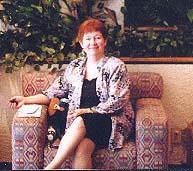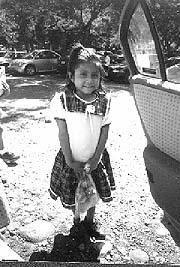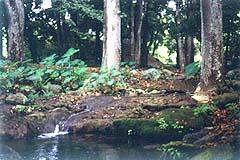I doubt any experience Ernest Hemingway had in Spain, or Africa, or at The Compleat Angler on Bimini could top my entrance into family life at El Mirador.
Daniel Casas, a man I never met, started building the El Mirador hotel in 1990 and it was completed in 1995. He died eight months before I met the family. The hotel just now needs repainting, which has been started. The building is a square, three-story structure with nothing to distinguish it except for a fish and a tiger painted on the wall on the third floor. I had almost forgotten about it until this last trip. I have to ask the girls about the tiger. The fish seems obvious – they are on a beautiful river, and raise their own fresh fish in concrete tanks just above the river. The tiger eludes me.
My only irritation with this place is I can’t get my coffee before 8:30 a.m. when the kitchen is open for business. I understand the reasons; it just inconveniences me.
During my second visit to El Mirador I was invited on several occasions to look into the pots in the kitchen to see if I wanted the day’s special. I get to go in and out the backdoor like family, but I still haven’t been invited to make myself a cup of coffee early in the morning.
El Mirador is a family hotel and family life centers here. The children, grandchildren, nieces and nephews, and adopted children, all help out whenever needed, and otherwise make their headquarters here in this hotel that is more like a huge farm house where paying guests are taken in. Most of the guests are Mexicans, who come to soak in the “termales”, but I understand an occasional Canadian or American stays here. I’ve yet to encounter any.
The ground floor of the hotel is devoted to a large dining room with five oilcloth-covered tables, (more or less depending upon how many you group together), a long, narrow kitchen with just a counter separating it from the dining room, (good for inspection – it is clean and orderly and they have their inspection papers from the government to prove it). The corner by the kitchen is devoted to stacks of crates containing soft drinks and beer. Across the room from the kitchen is the small office containing two sewing machines for sewing the hotel linens, and family clothes. At least two of the grandchildren sleep on the floor in here because they insist on falling out of bed, according to their mother. This corner is also used for sorting baskets of limes or mangoes for market when they’re in season. In the back corner is a room with a curtained door where Señora Casas sleeps at night and rests during the day.
Early in the morning the children are dressing for school and the family is generally getting itself together to start the day. I came down at seven one morning and found little Diana, the seven-year-old on the sofa pulling on her school clothes. I still don’t know where the rest of the family sleep. I believe they have houses within walking distance, but haven’t been invited there yet. I do know that sometimes when there are no other guests except me, some of them sleep in a room on the second floor because I’ve met Montserrat (Montsy) a beautiful 13-year-old granddaughter coming out of a room on the opposite corner from mine dressed for school.
A few times I have managed a cup of coffee a little after 8:00 if the kids are dressed and waiting to go to school. I indulged in some people-watching a few mornings and learned that one grandson, Gari rides his bicycle to school along with a cousin who rides his bike across the swinging bridge and meets Gari in front of the hotel. Diana gets a ride with her teacher who has a nice modern car, and wears tight jeans and high heels. I think Montsy rides a “rurale”, a Nissan two-seater truck that serves as a taxi, between Aguas Caliente and Xotla. It costs about 40 cents U.S. The kids go to school in shifts; I just have to work out who goes when. But afternoon is when things crank up with the kids in the hotel.
I came into the dining room about 12:15 p.m. one day to find little Diana at a table sniffing and working on her homework. I sat down and took out my notebook and began writing. Out of the corner of my eye I could see Diana pause occasionally and watch my rapid longhand, then she would print furiously in imitation. She ignored me when I took a picture of her bent over her book. She is a real beauty. They have all accepted the writing and photographing as part of Señora Carolina’s eccentricities.
That same afternoon a grandson, Daniel, came in with his English homework looking for help. Another older grandson, who works at the hotel since he finished all the schooling he can get, joined us. His name is Raul. He is tall, slender, and delicate in a masculine way. I always address him in English, and he replies correctly most of the time. The three of us worked for over an hour on Daniel’s English lesson. His eyes lit up in understanding when I separated the dialogue into word-for-word translation and the portions that were not word-for-word, but phrased according to the way the thought is expressed in each language. I got the idea that this was the best English homework he could turn in yet. During the hour, they also helped me with Spanish words and phrases. We were altogether satisfied with our afternoon’s work.
When we were done Daniel asked me something about a trampa and camarones and lampara. I was hoping for some river shrimp, but what he was giving me was a trap woven from a vine that they use in the river to catch the large “camarones” or shrimp. The fancier hotel down the river uses the “trampas” for lampshades. They do look good. I didn’t know what they were last year when we ate at that restaurant. Now I own one. I put it in a cardboard box, tied it loosely, and checked it at the airport. If it could survive the rushing waters of that river, it could take airport baggage handling. It arrived in perfect condition at the Atlanta airport. It sits now on a cedar chest in the Great Room here in North Carolina sporting some winter flowers.
Another day I worked with Gari, one of the grandchildren who sleeps on the floor in the “Office”. Like his cousin Daniel, Gari is quick in understanding his English lesson. He also added to my Spanish education. Later in the week he and his sister, little Diana, and their cousin, the beautiful Montsy, worked for several hours making a heart-shaped box and a wooden “palomito” (little dove) for me. Both adorn my window in the Great Room. I took pictures of Gari at work with his tongue between his teeth in concentration as he worked.
I can’t wait to get back to my “Hotel Family”







